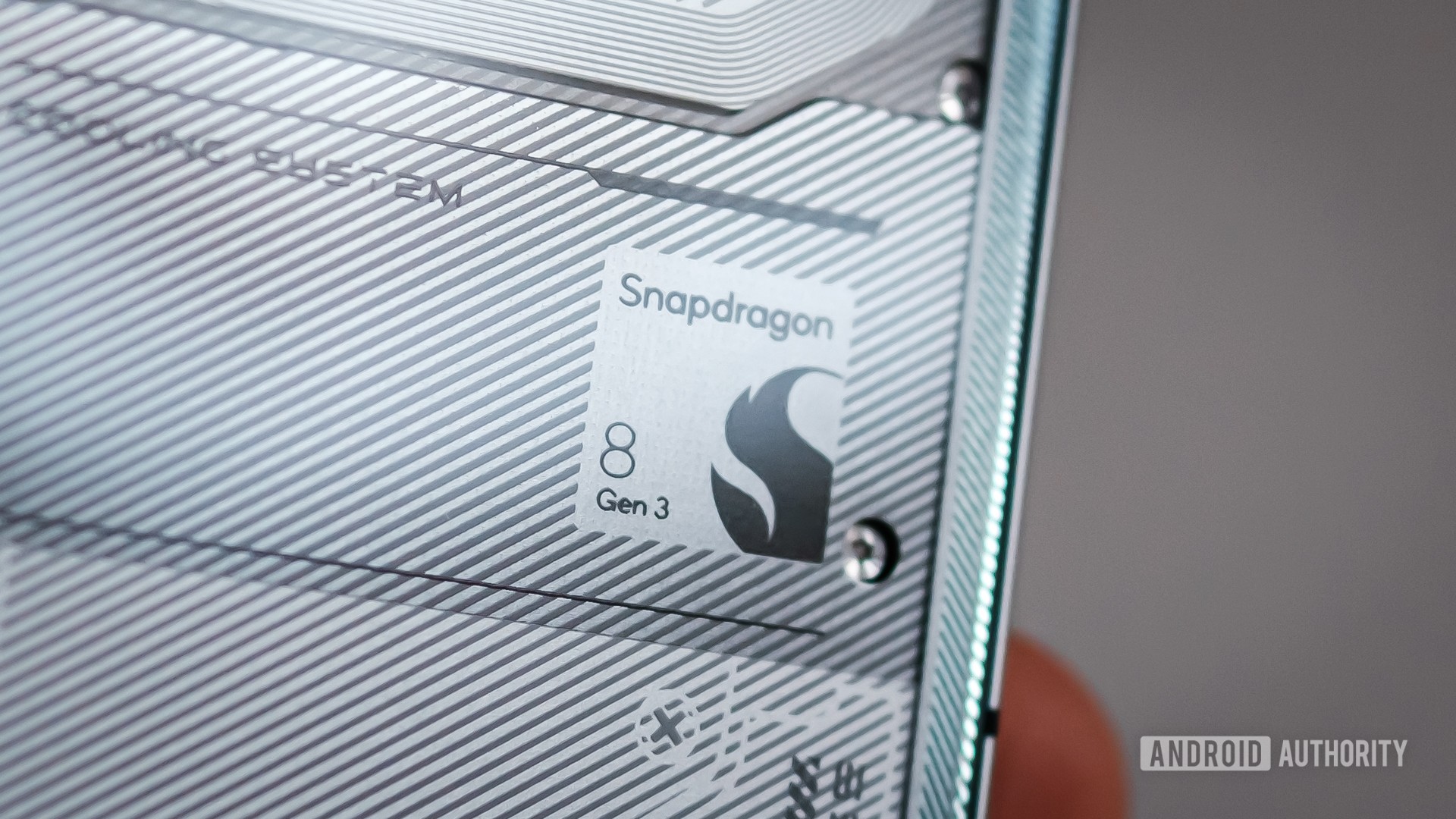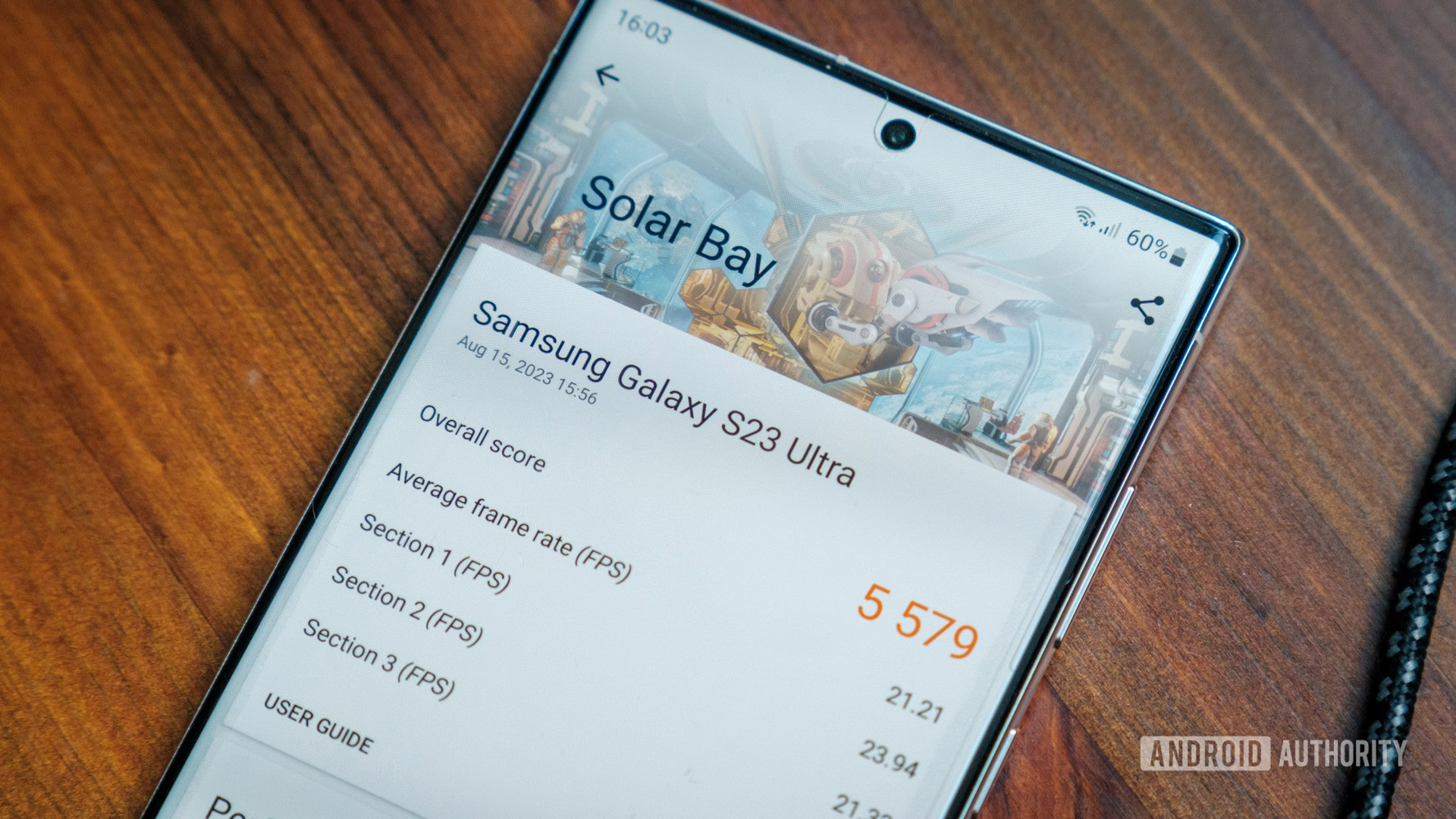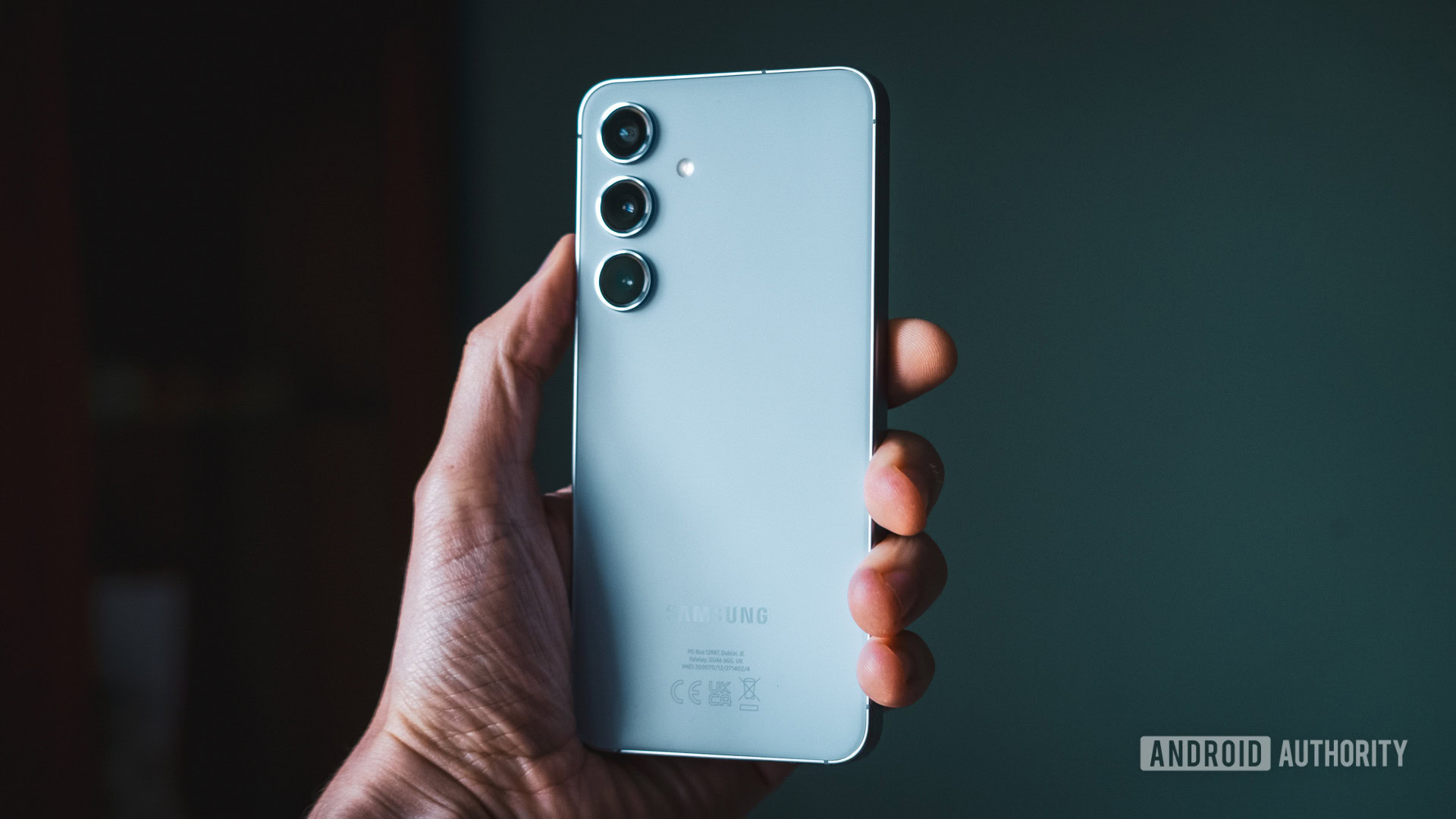Affiliate links on Android Authority may earn us a commission. Learn more.
Snapdragon 8 Gen 3 benchmarks rival the Apple A17 Pro
Qualcomm’s next-gen Snapdragon 8 Gen 3 processor powers some of the best Android smartphones of 2024. We have several 8 Gen 3 phones in hand, including the Samsung Galaxy S24 series, and couldn’t resist benchmarking the phone to see how it performs.
Previously, we grabbed one of Qualcomm’s Snapdragon 8 Gen 3 reference phones at Tech Summit, so we can also compare references against commercial design. We ran our usual suite of performance benchmarks to see how the chip stacks up.
For background, Qualcomm’s reference phone is powered by a Snapdragon 8 Gen 3 at standard clocks, 16GB LPDDR5X RAM at 4.8GHz, 512GB of fast UFS4.0 storage, and a 144Hz 6.65-inch 2,340 x 1,080 resolution display. That’s a very high-end setup but should reflect next-gen phones heading our way in 2024, perhaps bar the RAM count. The RedMagic 9 Pro has a very similar 16GB LPDDR5x RAM, a 120Hz 2,480 x 1,116 resolution display, and UFS4.0 storage.
Snapdragon 8 Gen 3 reference benchmarks
To start, let’s compare Qualcomm’s reference points against those of the previous generation. Starting with GeekBench 5 (GeekBench 6 released after the 8 Gen 2), we see a 15% jump in single-core performance with the move to the powerhouse Arm Cortex-X4 core from last year’s X3. Multi-core performance sees a much larger boost, owing to the novel 1+5+2 CPU core setup, which introduces an extra middle CPU core (a Cortex-A720) at the expense of one smaller low-power core. Peak performance is up 31%, a potential game changer for heavily multithreaded workloads.
PCMark scores are also up by 15%, showcasing that pairing the phone with high-performance memory and a robust scheduler can still lead to a significant performance boost across various common workloads, from data manipulation to video editing. However, this is the area where manufacturer implementations differ greatly from the peak performance offered by Qualcomm’s reference unit.
Qualcomm claims its latest Adreno GPU is 25% faster than the previous generation, which seems to bear out as a minimum. Our 3DMark Wild Life scores jumped by a colossal 40%. The Snapdragon 8 Gen 3 has made Vulkan-specific API improvements in addition to broader performance enhancements, which might explain the larger-than-anticipated performance differential here. This is obviously good news for gamers; Vulkan is the increasingly popular cross-platform API and is used for ray tracing. More on that in a moment. But as we’ll see later, peak performance isn’t the same as sustained.
We’ve tracked Qualcomm’s reference phones since the introduction of the Snapdragon 8 moniker. Looking back over three generations (and the 8 Gen 1 Plus refresh), there are some frankly colossal gains on display. In just three short years, peak multi-core performance is up by over 80%, according to GeekBench, as is graphics performance. Not to mention that energy efficiency continues to improve, ensuring that these extra capabilities don’t come at the expense of battery life. And that’s without bringing up the gains in networking and machine learning capabilities. Modern flagship smartphone chips continue to impress.
How does the Snapdragon 8 Gen 3 compare to current phones?

Qualcomm’s Snapdragon 8 Gen 3 reference phone represents an idealized level of performance that 2024 flagship smartphones would aim for. But now that we have the ASUS ROG Phone 8, OnePlus 12, Galaxy S24, and others in hand, we have a clearer picture of how commercial handsets perform. Whether you’re looking at high-performance gaming phones or more mainstream models, performance is bountiful, but there are some slight differences in the implementations.
As you’d expect, the jump to a more powerful CPU setup propels the handsets near the top of our benchmarks. However, none of the phones we’ve seen doesn’t quite live up to the promise of the 8 Gen 3 reference handset out of the box. Some phones achieve top-tier results by throwing caution to the power consumption winds and enabling high-performance modes.
Even then, the biggest Arm Cortex-X4 CPU doesn’t beat Apple’s powerhouse cores in GeekBench 6 single-core. Nor does the Snapdragon 8 Gen 3’s heavily loaded middle-core setup best the Apple A17 Pro’s six-core arrangement, but the results are not miles away. The A17 Pro is only 3% faster than the 8 Gen 3 in multi-core workloads but holds a strong 30% single-threaded lead. Still, the latest chips from Apple and Qualcomm are seriously pushing ahead from previous generation models.
It’s a similar take on the GPU side. Results don’t quite hit the heights of the reference phone we tested months ago, but it’s still hard to be disappointed. The Snapdragon 8 Gen 3 flies past last year’s model and beats out the A17 Pro and MediaTek’s Dimensity 9300, too. Qualcomm’s claims of a 50% boost to ray-tracing capabilities have also materialized; the 8 Gen 3 is also around 30% faster than Apple’s silicon here. This is great news for those planning to play the latest cutting-edge games.
Apple retains a slim CPU edge, but the 8 Gen 3 blast past in graphics and ray-tracing capabilities.
PCMark is an interesting comparison point, as its workloads consist of more typical day-to-day tasks that don’t necessarily fully strain the system in the same way that GeekBench 6 and 3DMark do. Spreadsheet data manipulation, video encoding, and photo editing showcase how important a well-optimized system scheduler and memory are for these upper-mid-tier tasks. Moving up to an 8 Gen 3 doesn’t automatically guarantee a much faster experience here, as there’s quite a variety between the phones we’ve tested.
Snapdragon 8 Gen 3 stress test

The REDMAGIC 9 Pro, ASUS ROG Phone 8 Pro, and others offer a higher performance mode when in game mode. We ran our stress test benchmarks in the default and high-performance modes, revealing some interesting properties about the chip’s performance under stress.
In default mode, the REDMAGIC 9 Pro throttled back from its peak performance level after just a couple of runs. That’s not completely unusual, but the sheer drop in performance to below peak 8 Gen 2 levels in the Wild Life test is concerning. Perhaps worse, the default performance mode dips below 8 Gen 2 devices in the Wild Life Extreme and Solar Bay tests. However, the phone maintains a higher level of performance than the 8 Gen 2 as the tests go on. While our stress test is typically far more demanding than most games, the size of this drop is worrisome for real-world performance. We don’t observe quite the same drop with the ASUS ROG Phone 8 Pro gaming phone, but the handset is still far more conservative for day-to-day use cases compared to running flat out. Other 8 Gen 3 handsets also throttle quite aggressively in this test.
However, flip the REDMAGIC 9 Pro’s performance mode on (complete with fan) and ASUS’ X-Mode, and the phones perform nearly flawlessly for our entire test. Ray-tracing eventually takes its toll on the GPU, but the 8 Gen 3 realized its full potential for extended periods in our other two tests. As we’ve come to expect, robust cooling is essential to maximize performance from flagship GPUs. I guess the “good” news is that we see just below peak 8 Gen 2 performance, even in the worst case.
However, scores are just half the picture. The performance mode also chugs down more than twice the juice and adds over 14°C to peak temperatures on these two gaming phones. The estimated screen-on time across the three stress tests dropped from a respectable four hours (that’s very good for a stress test) to just two hours. While the cooling fan will add some power consumption, additional energy to sustain high GPU performance is the major contributor. Based on the temperatures and power drain, I don’t think running the latest Adreno GPU at full tilt is very viable in a smartphone form factor.
Active cooling and a big battery are required to run Adreno at full tilt for extended periods.
The takeaway is that we will see performance and throttling discrepancies between flagship phones in 2024. Those with insufficient cooling will likely struggle to sustain peak performance for extended periods in very demanding workloads. Equally, phones targeting longer battery life likely won’t hit these very high-performance levels for long, either.
Since mainstream flagships have passive cooling and smaller batteries, we may see a bigger discrepancy with gaming phones than in previous years. Still, dubious stress test performance has been the case for several Snapdragon generations, as graphics performance continues pushing the mobile form factor’s thermal and power boundaries. Fortunately, many games are not as demanding as this stress test and will not see the same performance or battery issues.
What to know about Snapdragon 8 Gen 3 flagship phones

Clearly, the Snapdragon 8 Gen 3 is more performant than last year, and is one of the more notable leaps in recent times. With a huge boost to graphics and ray tracing performance and a more novel CPU setup, the 8 Gen 3 blasts past the 8 Gen 2, Google’s Tensor G3, and scores some wins over Apple’s powerhouse A17 Pro as well.
MediaTek’s Dimensity 9300 offers exciting competition this year too, which we’ll delve into more detail later. While the chip nudges marginally ahead in the CPU department, thanks to its beefy CPU clusters, the 8 Gen 3 seems to have the edge in graphics benchmarks. That said, real games aren’t as demanding as our stress test, so the real-world gap may narrow, at least in the short term.
In a nutshell, there’s plenty to be excited about for 2024 Android flagship phones on the performance side. The 8 Gen 3 offers a notable performance uplift, complete with machine learning improvements to run real-time generative AI, XPAN Wi-Fi audio technology, and Apple-like seamless connectivity. Furthermore, we’ve seen the chip’s enhanced AI capabilities power exciting new features like Samsung’s Galaxy AI suite. That being said, sustained peak performance remains the most pressing worry, especially in smaller phones with little room for cooling.